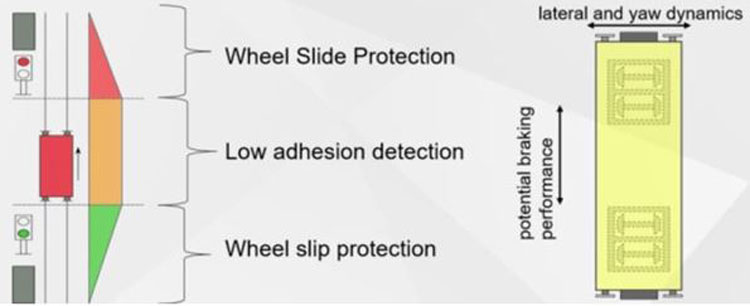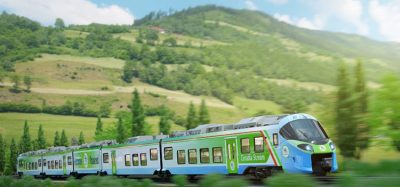New on-board system developed to instantly detect ‘leaves on the line’
Posted: 7 January 2022 | Global Railway Review | No comments yet
To combat low adhesion hazards such as leaves on rail lines, engineers and researchers have partnered to develop an on-board train system that will instantly detect issues and hazard hot spots.


Researchers are developing an on-board system for trains that can identify low adhesion hazards such as ‘leaves on the line’, as well as other issues that cause the rail equivalent of black ice.
Low adhesion is caused by the contamination of railways lines by biological, chemical, and physical factors, some of which cannot be easily monitored or controlled. The estimated overall cost of low adhesion to the UK railway industry is estimated at £350 million each year (RSSB).
A minimum level of adhesion is essential for reliable braking and traction performance, especially for maintaining safety and limiting delays. Changes in adhesion can be very localised, unpredictable and transient, and poor adhesion experienced by one train may not affect following trains at the same location.
Now, engineers from Loughborough University, the University of Sheffield and engineering firm Perpetuum have partnered to develop a new product that will detect low adhesion hot spots in real-time and create an up-to-date map of the UK’s network, which shows where any hazards might be.
The map will allow network operators to react quickly to potential risks allowing services to run more safely and smoothly.
Loughborough’s Dr. Chris Ward, who is leading the initiative, said: “The network is in danger of low adhesion events occurring at all times and the industry takes the impact of these incredibly seriously.
“Network Rail and the wider rail industry invests huge amounts of money in rail head cleaning, controlling flora alongside lines and forecasting where low adhesion events may occur – but it’s not an exact science and affected areas may only be discovered after an incident has taken place.
“The areas of low adhesion can often be short-lived and various types of train can react differently to the conditions.
“This new technology, by detecting low adhesion in real-time from in-service vehicles, will allow for a much more accurate picture of where hazards lie on the UK’s huge network of track, which will mean a quicker response – such as defensive driving or railhead treatment – and as a result a safer network with fewer delays.”
The detection system will use established sensing methods to collect data that will then be processed using algorithms created by Dr Ward and colleagues at Loughborough.
The experimental software should pick up small changes in how the wheels of a carriage respond to different track conditions.
As a train passes over areas of low adhesion, the vehicle moves differently compared to running over tracks with high levels of adhesion.
Signals of the movements are picked up by sensors, that are then processed and turned into an assessment of adhesion level. If required, a warning could be sent to the driver or the wider network users.
Elaine Cockroft, Project Manager at Network Rail, commented: “The aim is to develop a first of type product addressing the issue of low adhesion on the wheel/rail interface and consider a tribometer/measurement tool capable of determining the co-efficiency of friction on the rail head.
“The medium-term aspiration is to install a device on the Network Rail Head Treatment Train (RHTT) or a Multi-Purpose Vehicle (MPV), or any other suitable vehicle to capture intelligent seasonal treatment data at a minimum speed of 60mph and to demonstrate the effectiveness of the rail head treatment.
“The future ambition is to add the technology to passenger trains or freight locomotives and so the technology would need to be developed to capture continuous data at a travelling speed of 125mph across the network. This would feed into an up-to-date adhesion map of the network.”
The 22-month study will see the research team conduct a major test programme in summer 2022 at Network Rail’s Rail Innovation and Development Centre to test their algorithms.
Artificial low adhesion will be created for the testing programme and measured using state-of-the-art friction measurement equipment from the University of Sheffield.
Professor David Fletcher from Sheffield, commented: “Our collaboration in the UK Rail Research Innovation Network has enabled us to develop a comprehensive suite of rail surface analysis hardware. We can now take our rail-wheel contact expertise from the lab and deploy it to site trials such as these with Loughborough.”


The ‘LAD system’ would complement existing methods of understanding the locations of low adhesion, such as the triggering of wheel slip and wheel slide protection systems. Credit: www.lboro.ac.uk
“Like any vehicle that rolls on wheels, railway vehicles rely on friction being created in the wheel/rail contact area for guidance and traction – e.g., steering, braking, and accelerating,” added Dr Ward. Rail systems have a specifically stiff and low friction contact area of steel wheels on steel rails. This is very efficient when it comes to energy loss during rolling and means that less energy is needed to maintain vehicle speeds compare to vehicles with tyres. This is due to very little contact area deformation – they are fingernail-sized – even with the huge contact pressures.”
Dr Ward continied: “Low adhesion in this contact occurs for a variety of reasons, but one of the most widely known is ‘leaves on the line’. The chemistry of the leaves, rain and the huge pressures create a material that is akin to ‘Teflon’ or black ice – very nearly zero friction. So, when brakes are applied vehicles can just slide. A recent example was a vehicle travelling at 100kmh (60mph) was expected to stop in 1km. Due to low adhesion, it took 5km. This means red signals can be passed, station stops missed, and collisions can occur. The main issue is that we don’t know with confidence that these conditions have occurred. There is no real-time measurement at present. This is the key point we are aiming to address with the technology and turn into a process that can be deployed on the live railway.”
Stay Connected with Global Railway Review — Subscribe for Free!
Get exclusive access to the latest rail industry insights from Global Railway Review — all tailored to your interests.
✅ Expert-Led Webinars – Gain insights from global industry leaders
✅ Weekly News & Reports – Rail project updates, thought leadership, and exclusive interviews
✅ Partner Innovations – Discover cutting-edge rail technologies
✅ Print/Digital Magazine – Enjoy two in-depth issues per year, packed with expert content
Choose the updates that matter most to you. Sign up now to stay informed, inspired, and connected — all for free!
Thank you for being part of our community. Let’s keep shaping the future of rail together!
Related topics
Related organisations
Loughborough University, Network Rail, Perpetuum, University of Sheffield







